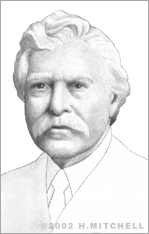David Hughes
David Edward Hughes was born in London, England in 1831. His family was musically talented – he, his sister, and his two brothers were considered prodigies, and the family performed together around the world. In 1838, the Hughes family emigrated to the United States.
Hughes became a professor of music at St. Joseph’s College in Bardstown, Kentucky in 1850. He also developed an interest in electrical engineering and brought his two main interests together when he began studying the transmission and amplification of sound. In 1855, he was awarded a U.S. patent for a printing telegraph, which he designed nearly by accident while attempting to create a machine to copy extempore music. His system used a keyboard in which each key would correspond to a letter that would be printed at a distant receiver. The invention, which came to be known as the Hughes Printer, was commonly used until the 1930s, after it was adopted and installed worldwide by the Western Union Telegraph Company.
Hughes had moved back to London during this time and had become well known around the world for his telegraph machine. He now had the means and the time to continue experimenting on his own. During his research, he discovered that a loose contact in a circuit containing a battery and a telephone receiver would give rise to sounds in the receiver corresponding to the vibrations impinged upon the diaphragm of the mouthpiece or transmitter. This discovery led to the development of the carbon microphone, which he unveiled in 1878. However, he refused to patent it. Hughes revived the term microphone, which was first used by Sir Charles Wheatstone in 1827, for his creation. He chose to give it to the broadcast and recording industries with no strings attached.
Hughes continued to study and experiment, eventually inventing the induction balance (which is often used as a type of metal detector), experimenting with aerial photography, and working with the theory of magnetism. His research papers on magnetism were presented at many scientific and technical society gatherings and contributed much to the field of electrical science.
Hughes was the recipient of many international honors and awards for his work, including a Fellowship of the Royal Society, a Grand Gold Medal in 1867, awarded at the Paris Exhibition, the Royal Society Gold Medal in 1885, and The Albert Gold Medal for the Society of Arts in 1897. In 1886, he filled the presidential chair of the Institution of Electrical Engineers.
Hughes died in London on January 22, 1900.


